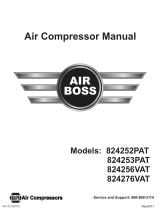
To reduce the risk of electrical hazards, fire
hazards or damage to the compressor, use
proper circuit protection. Your compressor
is wired at the factory for operation using
the voltage shown. Connect the compressor
to a power source with the correct breaker
size.
Adequate wiring and motor protection
should be provided for all stationary
compressors. Wiring used for other
machinery should not be used. A
qualified electrician familiar with local
electrical codes in your area should be
used.
WIRING
ALL ELECTRICAL WIRING SHOULD BE DONE
BY A QUALIFIED ELECTRICIAN
General Information
STARTING THE COMPRESSOR
Prior to actually running the compressor,
check the following items:
Crankcase oil - Make sure the sight glass
shows ½ full or slightly above.
Make sure all rags, tools, oil, etc. are away
from the unit.
Open the air system to free it of any pressure.
Switch the compressor on for a few
revolutions to make sure the rotation is
correct. Correct rotation is clockwise
when facing the sight glass on the pump.
Operate the compressor for a few minutes
unloaded (air system open) then allow the
compressor to pump up. Make sure the
electrical pressure switch properly switches
off the compressor according to the setting
desired. (135 psi for K7045V/K7060HFV
and 175 psi for K7580V2)
Make sure the pressure in the tank does
not exceed its rating. Single stage comp-
ressors should operate at a maximum of
135 psi and two stage compressors should
operate at a maximum of 175 psi. If the
pressure gauge indicates a pressure that
is higher than these maximum pressures,
shut off compressor immediately and call
1-866-242-4298.
K7045V
K7060HFV
K7580V2
Voltage
FLA
Breaker Size
230V / 1 ph 230V / 1 ph
16
23
40 amp30 amp
Incoming power should
be connected to the
posts marked (line)
Do Not Make
Connections On
Prewired Posts (Motor)!
Grounding Screw
Electrical connections must be properly
grounded. Ground connections should be
connected at the grounding screw.
The motor is equipped with a manual,
resetable overload device to protect it from
overheating. In the event the compressor will
not run and power is properly connected and
on, press the motor overload reset button
located on the non drive end of the motor.
Overheating, short circuiting and fire damage
will result from inadequate wiring.
WARNING
WARNING
WARNING
CAUTION
WIRING
STARTING THE COMPRESSOR
CAUTION
Page 6
!
DANGER
Low discharge pressure
1. Reduce air demand or use a compressor
with more air capacity.
2. Listen for air leaks. Apply a soap solution
to all fittings and connections. Bubbles
will form at points of leakage. Tighten
or replace fittings or connections.
3. Clean or replace air filter.
4. Replace necessary gaskets.
5. Remove head and inspect for broken or
misaligned valves. Replace valves, if
necessary.
Install a new head gasket
each time head is removed
1. Tighten drive pulley or flywheel bolt.
2. Check for proper oil level. Low or dirty
oil may cause bearing damage.
3. Replace connecting rod and/or connecting
rod bearings.
4. Replace check valve.
Do not remove check valve
with air pressure in tank
1. Replace with new piston rings.
2. Clean or replace air filter.
3. Drain oil to proper oil level.
4. Use a quality non-detergent 30 or 40wt
oil specified for each model (Page 4).
1. Drain tank at least once per day.
2. Add an inline filter to reduce moisture in
in the air line.
1. Check voltage with volt meter across both
legs of incoming power. Check reset button
on motor.
2. Repair or replace pressure switch.
3. Replace check valve or pressure switch.
Do not remove check valve
with air pressure in tank
1. Make sure the breaker is sized properly.
See page 6 in this manual.
2. Check voltage with volt meter across both
legs of incoming power.
3. Replace motor.
4. Check all electrical connections.
5. Adjust or replace pressure switch.
6. Replace check valve.
Do not remove check valve
with air pressure in tank
1. Replace check valve.
Do not remove check valve
with air pressure in tank
2. Tighten or replace fittings or connections.
3. Replace tank. Do not attempt to repair tank.
1. Compressor too small for
application
2. Air leaks
3. Restricted intake air
4. Blown gasket(s)
5. Broken or misaligned valves
!
DANGER
!
DANGER
!
DANGER
1. Loose drive pulley or flywheel
2. Low on oil
3. Worn connecting rod or
connecting rod bearing
4. Noisy check valve
1. Worn piston rings
2. Restricted intake air
3. Too much oil in compressor
4. Incorrect oil viscosity
1. Normal. Amount of water will
increase as humidity in the
air increases.
1. Low voltage
2. Malfunctioning pressure switch
3. Malfunctioning check valve
1. Incorrect breaker size
2. Low voltage
3. Malfunctioning motor
4. Loose electrical connections
5. Malfunctioning pressure switch
6. Malfunctioning check valve
Tank does not hold
pressure when not
running and shut off
valve is closed
Breaker or reset
repeatedly trips
Will not run or motor
hums
Water in tank and/or
discharge line
Excessive oil carryover
Excessive noise
“knocking”
TROUBLESHOOTING GUIDE
1. Malfunctioning check valve
2. Loose fittings or connections
3. Crack or pin hole in tank
Page 7
CAUTION
!













